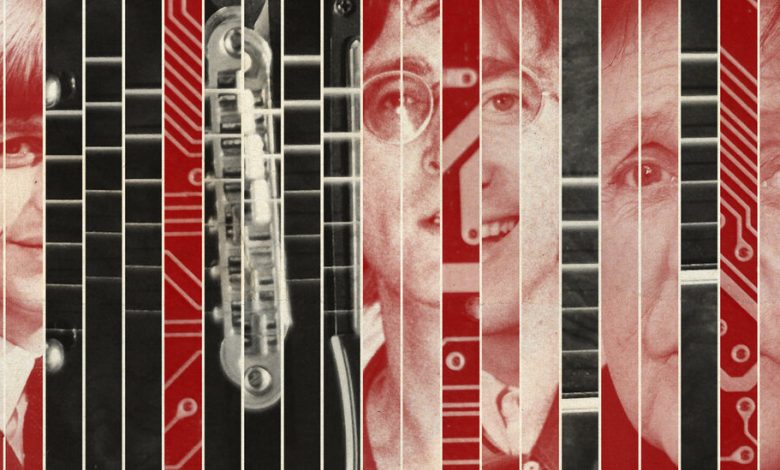The Beatles Are Still Charting the Future of Pop. It Looks Bleak.

Earlier this month, alongside the arrival of a new Beatles single called “Now and Then,” there also came a 12 minute and 24 second promotional film — exactly three times as long as the song itself — explaining the project. Why so long a preface? Part of it was the solemnity of the occasion: This was, the film’s title card proclaimed, “the last Beatles song.” But there was another purpose, too, one that was uncomfortably hard to miss.
“Now and Then” requires not just explanation but also, awkwardly, justification. The song was originally a demo recorded by John Lennon in his New York apartment in the late 1970s, well after the Beatles broke up. In the 1990s, it was among the recordings that Yoko Ono provided to Paul McCartney, George Harrison and Ringo Starr as candidates for being polished up into fully arranged songs. Two of those — “Free as a Bird” and “Real Love” — were released in the mid-1990s, as part of the “Anthology” series of TV documentaries, compilation albums and a book. But “Now and Then” was abandoned, in part because of technical difficulties in separating Lennon’s vocals from the murky piano on the same audio track: This was the audio equivalent of a scribbled note to self, not a usable studio recording. Decades later, though, in the course of making the 2021 documentary “Get Back,” the director Peter Jackson’s production company developed a cutting-edge machine-learning application that could be trained to tease apart components of recordings. Suddenly it was possible to isolate individual Beatles’ voices from garbled footage of them in studios and rehearsal halls as they conceived and recorded the album “Let It Be.” Applied to “Now and Then,” this new technology set Lennon’s singing free.
The moment when the promotional video evokes this jailbreak — playing Lennon’s isolated voice over footage that juxtaposes his face with an empty studio — is admittedly chills-inducing. The video is full of similar juxtapositions. We see the astonishingly well-preserved Paul McCartney of 2023, marveling at the gifts of technology; then we see him in the ’90s, goofing around with a still-alive George Harrison; then the bearded family man of the late ’60s, then the fresh-faced Liverpudlian lad suddenly catapulted to stardom. Time collapses: Beatles past and present, “now” and “then,” come together, Lennon’s voice from the ’70s layering with Harrison’s contributions from the ’90s “Anthology” sessions, McCartney and Starr’s more recent efforts, even scraps of wordless harmony singing borrowed from ’60s recording sessions and tracks like “Eleanor Rigby” and “Because.”
It’s so moving that it took me a few rewatches, over a few days, to start asking the obvious questions. Centrally: Does it really make sense to use a song originally written by Lennon alone, with no known intention of ever bringing it to his former bandmates, as the basis for a “Beatles” song? Is Lennon’s vocal, plucked and scrubbed by artificial intelligence and taking on a faintly unnatural air, something he would have embraced or been repulsed by? “Is this something we shouldn’t do?” McCartney asks in a voice-over, but neither he nor anyone else ever articulates exactly what the problem might be. Instead, the film answers unspoken objections by repeatedly swatting them down. McCartney imagines calling his old bandmate up — “Hey, John, would you like us to finish this last song of yours?” — and then supplies Lennon’s answer for him: “I’m telling you, I know the answer would’ve been ‘Yeah!’ He would have loved that!” John “would have loved” the approach, his son Sean concurs — “He was never shy to experiment with recording technology.” In the song’s music video, directed by Peter Jackson, a youthful Lennon is spliced into the “Now and Then” recording sessions: He does, indeed, look thrilled.
“We’ve all played on it,” McCartney says. “So it is a genuine Beatle recording.” On one hand, who is more qualified than McCartney to issue this edict of authenticity? On the other: Why did he feel the need?
To date, much of our conversation about A.I. tools and art has focused on what “new” material a computer program can possibly generate on its own. (Can DALL-E spit out a great painting? Can Midjourney create a genuinely good movie? When, if ever, will ChatGPT write an excellent novel?) But the successful rollout of “Now and Then” — within days, it was topping charts in Britain and nearly there in America — suggests another, and I think more plausible, path for A.I. and the business of culture. This path has less to do with software producing new work and more to do with tech advances facilitating the ongoing monetization of existing intellectual property, “content” that is already identified as profitable.
We are awash in reboots and rehashes and rereleases, sequels and prequels and spinoffs, movies about toys and toys inspired by movies — and, as the recent Hollywood strikes brought to public attention, movie studios are eager for opportunities to assert ownership of writers’ and actors’ creative output as the fodder and training data for cost-cutting A.I. tools. This past summer, YouTube introduced a “Music A.I. Incubator” with Universal Music Group artists including, according to one news release, “the estate of Frank Sinatra.” Peter Jackson has acknowledged the possibility that the Beatles archives could, revisited with fresh tools, generate even more new material. (This is, after all, the man who stretched J.R.R. Tolkien’s slim “The Hobbit” into three full-length movies.) On McCartney’s recent tour, he performed “duets” with Lennon, melding his live show with A.I.-isolated vocals from a concert featured in “Get Back.” A.I. didn’t birth rehash culture, but it seems sure to accelerate it.
So while the current legacy-I.P. production boom is focused on fictional characters, there’s no reason to think it won’t, in the future, take the form of beloved real-life entertainers being endlessly re-presented to us with help from new tools. There has always been money in taking known cash cows — the Beatles prominent among them — and sprucing them up for new media or new sensibilities: new mixes, remasters, deluxe editions. But the story embedded in “Now and Then” isn’t “here’s a new way of hearing an existing Beatles recording” or “here’s something the Beatles made together that we’ve never heard before.” It is Lennon’s ideas from 45 years ago and Harrison’s from 30 and McCartney and Starr’s from the present, all welded together into an officially certified New Track from the Fab Four.
In that context, the “Now and Then” movie’s upfront billing of the track as the last Beatles song feels like a two-pronged rhetorical move. As a promotional matter, it maximizes our sense of the release as an event. But it simultaneously functions as a reassuring promise. Look, it seems to say, we won’t be doing this left and right. We’re too classy for that; we’re the Beatles. This is about the realization of a longstanding and deeply emotional artistic goal, not about cravenly generating a new product.
Well, maybe. But the truth, ultimately, will lie not with any facts inherent to the universe of existing Beatles recordings. It will come down to choices made by whoever owns the rights. If you can make a Beatles single using ideas from two dead Beatles, then you can make one with ideas from three dead Beatles — or even, perhaps, from four. And even if this really is the end for Beatles output, it would be foolish to think that no one will follow in their footsteps. Somewhere, right now, people in suits are drawing up profit projections for similar projects from other beloved acts.
Whether this fact fills you with dread, indifference or excitement might depend on what you think of the music that results. Thus far, many applications of artificial intelligence to music have been meme-y novelties: people mocking up (surprisingly good) impressions of Drake songs or Johnny Cash covering Taylor Swift or Hank Williams singing rap lyrics. The next step — the one the “Now and Then” promotional film is so eager to reassure us “the Beatles” have not yet taken — is the use of A.I. to produce songs we’re meant to respond to not as neat proofs of what’s technically possible, but as vectors for emotion.
I’ve seen numerous people describe how genuinely moved they were by listening to “Now and Then.” I believe them. And the experience of communing with lost friends and collaborators was obviously an especially meaningful one for McCartney. For me, though, the song is eerily inert. Lennon’s original shoddy demo, long available online, is, by contrast, movingly alive, not despite but because of its incompleteness. The recording generates an aura of possibility that fits with the song’s themes: all that might have been, the power of what endures over time, even as so much else erodes. It reminds me of the Beatles without sounding like the Beatles — and why should it, when Lennon didn’t write it for them? The new “Now and Then,” for which some of Lennon’s original lyrics were cut and others rearranged, doesn’t entirely sound like the Beatles either, no matter how much it wants to. The image that formed in my mind as I listened and relistened was that of a spotless, echoey mausoleum, built from shiny gray marble and haunted by garbled digital cries that sound like people I once knew, trying to connect across impossible distances.
My suspicion is that I’ll be having this uncanny feeling more often in the years to come. This will be, in part, because of what A.I. will make possible and how widely it will be deployed as a tool for duplicating human sounds. It will also be a result of our ongoing collective failure to create conditions that make the production and widespread dissemination of novel art possible. What’s worrisome is not the technology itself, which has the potential to be deployed in all sorts of artistically interesting ways. Neither is it a matter of what is or isn’t “natural,” or of policing the boundaries between “real” and “fake” Beatles. The worry is that, for the companies that shape so much of our cultural life, A.I. will function first and foremost as a way to keep pushing out recycled goods rather than investing in innovations and experiments from people who don’t yet have a well-known back catalog to capitalize on. I hope I am wrong. Maybe “Now and Then” is just a blip, a one-off — less a harbinger of things to come than the marking of a limit. But I suspect that, in this late project, the always-innovative Beatles are once again ahead of their time.




